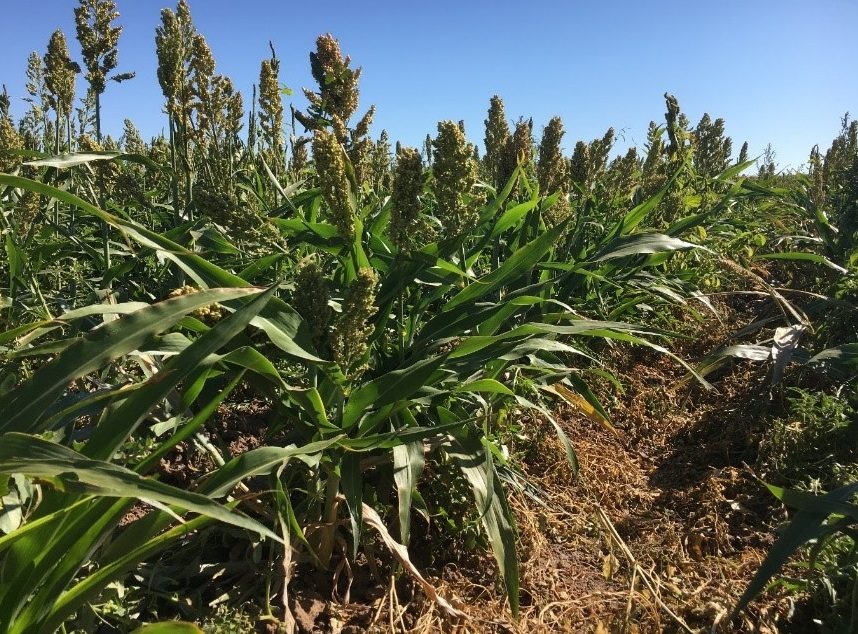Quick Facts
- Post-emergent, non-selective herbicides can be used to manage weeds growing in and around certified organic food crops. They are allowable with restrictions.
- The active ingredients caprylic and capric acid quickly “burn down” small annual and perennial weeds (≤2” in height).
- Annual weeds will generally die and not regrow, while perennial weeds will regrow in about 14-21 days.
- Pay close attention to the application volume. Organic herbicides are more effective at higher application volumes compared to many conventional herbicides.
- Scale-appropriate implements such as shielded-sprayers can be used to help protect the crop from herbicide injury with non-selective herbicides.
Weed management is a critical aspect of organic specialty crop production (e.g. vegetables, small fruits, ornamentals etc.). Weeds compete with the crop for light, water and nutrients. They can negatively impact yield and overall quality in vegetable crops. For example, it is estimated that weeds can reduce vegetable yields by 45% or more depending on the level of weed pressure and the sensitivity of the crop to competition (Mennan et al., 2010). Specifically, weed pressure in peas reduced yields by 25-30%, while onion yields were reduced by 67% (Singh et al., 2019). Weeds that go unmanaged in an onion crop can impede bulb formation, which could lead to crop failure.
Fortunately, specialty crop producers have numerous weed management tools at their disposal. Preventative and cultural practices as well as chemical controls are a few options for managing weeds. In organic systems, integrated weed management (IWM) is the coordinated application of prevention tactics, avoidance mechanisms, monitoring systems, and weed suppression actions (Wilson et al., 2009). In addition, IWM affords producers the flexibility to tailor their plan based on the available management inputs, weed pressure, crop sensitivity, and the potential financial returns of their production system. High-value vegetable crops such as organic tomatoes or leafy greens sold at direct-to-consumer markets, for example, may warrant a larger financial investment in weed control inputs as compared to relatively lower value crops such as commodity grains. However, cost is not the only consideration in selecting a management input.
The herbicide inputs that are allowable in organic systems are different from those used in conventionally managed agricultural production systems. It is important to note that herbicidal inputs for organic systems are “allowable with restrictions.” This means that preventative, cultural and biological controls must be employed and documented before organic certification rules allow the application of any herbicide, even those labelled for organic use. Rule 205.206(e) under the National Organic Program (2020) requires that preventive, mechanical, physical and other management practices are used (and documented) to control weeds before applying an herbicide, and the herbicide must be OMRI-approved and included in the organic system plan. In addition, that herbicide must be included in the organic system plan (OSP). If ever a question, ask your certifier first — and before taking action.
Before an herbicide can be used, the organic system plan dictates that a full suite of IWM practices are also employed including: crop rotation, mulches, cover crops, tillage, and hand weeding. Herbicides should be used sparingly to control weeds in “trouble spots” such as field edges and along the plastic mulch-soil interface of vegetable crops grown in plasticulture.
In the past couple of years, several new active ingredients (AI) have been approved by the Organic Materials Review Institute (OMRI, 2020) and/or by the Washington State Department of Agriculture (WSDA, 2020) for organic crop production (Table 1). These include acetic acid (e.g. Green Gobbler®), eugenol (e.g. Weed Slayer®) and capric/caprylic acids (e.g. Suppress®, Homeplate® and Fireworxx®). All are post-emergent, non-selective herbicides.
Green Gobbler® and Weed Slayer® are derived from the active ingredients acetic acid (20%) and eugenol, respectively. Suppress®, Homeplate®, and Fireworxx are all caprylic and capric acid-based product formulations. Post-emergent means that these herbicides are applied to weeds that are actively growing above the soil line. Non-selective denotes that any plant tissue (i.e. green) contacted by the herbicide will be damaged. Therefore, care must be taken to avoid significant crop damage; only spray vegetation you want to kill.
Given their non-selective nature, there are several ways to avoid herbicide drift such as changing droplet size and avoiding applications under windy conditions, if using a sprayer, for example. A shielding hood could also be used to target weeds actively growing between crops rows. This is a plastic or metal hood with a spray nozzle in the center, which serves to cover the weed canopy with herbicide, while shielding the crop from drift.
Table 1. Herbicide products, active ingredients, post-emergence, selectivity, and cost comparison.
| Herbicide | Active ingredient | Post-emergent | Non-selective | Cost/acrez |
| Suppress® | Caprylic/capric acid | Yes | Yes | $450 |
| Weed Slayer® | Eugenol | Yes | Yes | $300 |
| Green Gobbler® | Acetic acid | Yes | Yes | $619 |







Post a comment
Report Abusive Comment